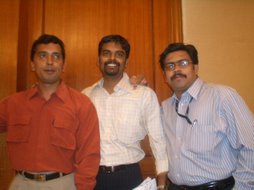i am in the midst of writing this article....
The global Economic Recession from a common man’s view
The world economy is showing some signs of growth but we need to wait to confirm if the worst is over.
India is in the midst of the global economic slowdown, unable to decide if it needs path breaking reform agenda to ensure it leapfrogs all others or be cautious and tread through this time period and be ready when the world is about to get back into the growth story that it had been in early 2008. For almost a year, people from different spheres of life were reluctant to accept that the world is in the grip of a real slowdown and the dreaded word recession was only taken out by the bold. But the entire world is in recession infact a real one for many decades – the first real one that I am going through.
According to some estimates around 75% of the economies are currently going through a recessionary phase or negative growth. Earlier warnings like the 2000 dot com bust or even the early 2003 economic crisis was not as synchronous as we had a situation where almost half of the world economy was showing signs of recovery. Hence it balanced out itself. But here a vast majority of the world is contracting and hence we do not see any major signs of growth. The world also is more and more like a level playing field and the boundaries are all peripheral and this has ensured the contraction to spread far and wide to all interrelated geographies unlike the earlier crisis when one region had a bad contraction but some other regions were not that deeply impacted.
Another genuine concern is over the ability of governments to raise the vast amounts of debt they need to pay for economic stimulus packages and bank bail-outs. Rough estimates suggest that globally around $ 3 trillion of debt is to be raised from government bonds. Although this does suggest that there is some bit of consumption growth but technically it is recession which is nothing but declining or negative private growth/ consumption being compensated by artificial government demand. The real fear is once the recessionary phase is over, for how long the tax payer’s will have to bear the additional pressure of paying off these government debt’s raised from the market. It is estimated that around $ 4 billion of toxic assets are to written off by the various financial institutions and governments by the time recession is declared officially over.
Number of hungry people in the world has touched 1 billion, a historic high due largely to the global economic crisis and high food prices. According to, the Food and Agricultural Organisation (FAO) report, compared with last year, there are 100 million more people who are hungry, meaning they receive fewer than 1800 calories per day. Almost all the worlds undernourished live in developing countries, where food prices have fallen more slowly than in the richer nations. This huge increase in the have-nots category has an indirect affect on global peace. All this despite strong 2009 cereal production but still the average prices at the end of last year were still 24% higher in real terms than in 2006.
Developing countries are expected to grow by only 1.2 per cent this year, after seeing a 8.1 per cent growth in 2007 and 5.9 per cent growth in 2008, according to a study titled 'Global Development Finance 2009: Charting a Global Recovery', by the World Bank. Asia and the Pacific, the world’s most populous region, have the largest number of hungry people at 642 million. Sub Saharan Africa with the highest hunger rate, with 265 million undernourished representing 32% of the regions population.
Some other key indicators to the gloomy economic scenario are - The global automobile industry sold 54 million vehicles last year in comparison to 68 million in 2007. According to Liases Foras, a real estate research firm, the developers' sales to inventory ratio in India has moved up to 1:9.5 (a unit of sales for every 9.5 units of inventory) from 1:2 in 2005.
Cause for Optimism
According to the latest estimates from studies, the German and the Japanese economy are showing signs of growing business positivism. The business in general in these two of the largest economies of the world is more confident of a demand pick up.
The number of US workers filing new claims for jobless benefits is still rising but the number of people staying on the benefit rolls after collecting an initial week of aid has fallen for the first time since January 2009.
The Indian economy is also not oblivious to the growth signs around the world, as the IIP has shown positive growth. The April- March 2009 figures for consumer durables categories have shown considerable growth. According to Org report, the high priced LCD TV segment has grown by 86%, followed by Plasma TV at 54%; flat TVs grew by 1%. Colour TVs account for over half the consumer durable market.
The Indian banking industry data also shows a general improvement in credit off take (lending). It is positive news that the demand for loans is improving especially from the fertilizer and infrastructure sectors.
Indian Infrastructure needs roughly $ 500 to 750 billion investments (depending on the general valuations of different institutions like planning commission estimates and other private institutions) and according to me the key to unlock our economic crisis. If the government has a single minded disciplined approach at solving our Infrastructure mess then it will definitely revive the economy and play a big part in ensuring the revival of the global economic crisis. We just need to have some ambitious targets like doubling our four lane highways to six lanes; a great dose of investment and private participation is high speed railway infrastructure, airport modernization (all the state capital’s airports need to be modernized), a separate express line railway infrastructure for carrying freight, linking and bypassing city roads with national highways, smart interlinking of state highways with national highways, a smarter policy in building ports (the existing method of having smaller ports may be every 30 or 50 kilometers is a very archaic thought process and according to a research study has lead to over 50 % of our beaches getting vanished as these small ports turns them into rocks), a major thrust on power with even greater emphasis of transmission and especially distribution – in power distribution, we need to get away with this rural and urban conflict and ensure the distribution benefits both, another concern is to make sufficient study before sanctioning a power/irrigation project and taking all the stakeholders views into consideration, a renewed thrust into renewable energy especially solar and wind power generation (I think we have a lot of untapped potential here).
Conclusion
When you look at the numbers it clearly is an improvement; let us say Work in Progress.
Subscribe to:
Post Comments (Atom)





1 comment:
Post a Comment